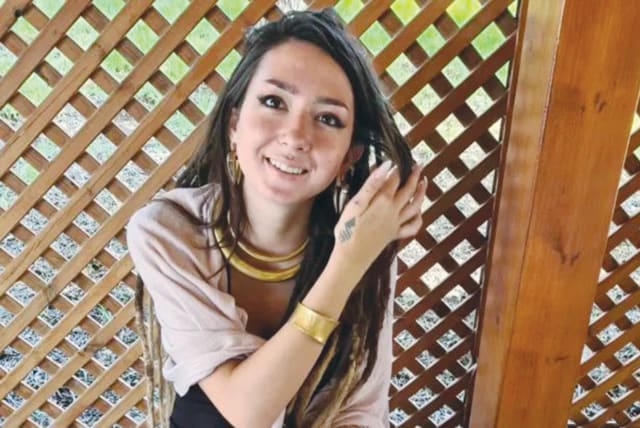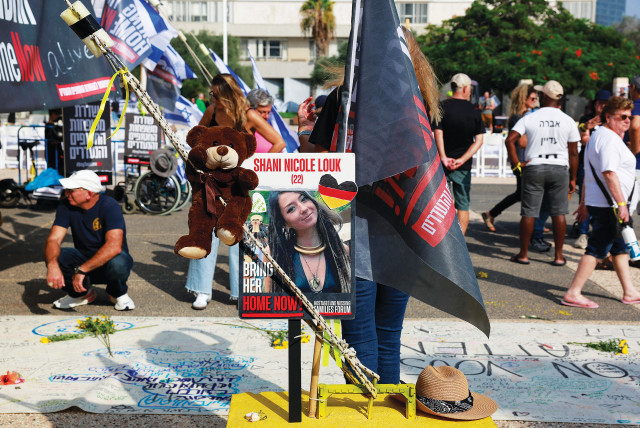'Photo of the Year' photographer of Shani Louk photo should be prosecuted - opinion

The Associated Press (AP) photograph, taken by freelance photographer Ali Mahmud, who accompanied the terrorists on October 7, has recently won the prestigious ‘Photo of the Year’ award.
Shani Nicole Louk was a 22-year-old peace-loving German-Israeli tattoo artist who was murdered during the Hamas massacre at the Supernova music festival on October 7. The sickening video and photo of her semi-naked body being paraded through the streets of Gaza on the back of a pickup truck, surrounded by terrorists, was one of the first viral images from that day.
The Associated Press (AP) photograph, taken by freelance photographer Ali Mahmud, who accompanied the terrorists on October 7, has recently won the prestigious ‘Photo of the Year’ award by the Reynolds Journalism Institute at the Missouri School of Journalism.
Sparking outrage, this award has led to a petition by “Justice for Shani” against Nikon, AP, and the Missouri School of Journalism. The petitioners claim that the photo “is not only disrespectful but also raises ethical concerns about photojournalism,” adding that “some photographers involved are even suspected to have had prior knowledge about these tragic events.”
There is no doubt that some of the photojournalists had prior knowledge of what the terrorists had planned for October 7. The question is, how much knowledge?
Any prior knowledge or suspicion that criminal acts were being planned would place a journalist under a moral obligation to report this information to the relevant authorities to prevent the attack from taking place, as far as possible. The fact that no such warnings were given raises a red flag as some of those journalists who intended to go along on October 7 must, at the very least, have had an inkling that the planned operation might involve harming civilians.
As journalists and truth seekers, it was incumbent upon them to find out more before they set off. What was the purpose of the mission and why was it planned for early morning, when everyone was asleep? These are just two basic questions that would have been posed beforehand by any respected reporter or photographer, freelance or otherwise.
If attempts weren’t made to ascertain these details, one can only assume that those accompanying the terrorists either knew about and supported the plan or else didn’t want to know. Even on the assumption that some agreed to participate in good faith and had no undue worries in advance, grave concerns must have been raised almost as soon as it began early that morning when the terrorists armed themselves with automatic weapons and began to plow into the security fence.
AT THAT point, there could have been no doubt that something horrific was about to happen, which would compromise their position both as journalists and more importantly, as human beings.
As soon as the massacre began, there was no legitimate reason for any of the journalists to stay. By remaining in place to take photos and videos of the crimes as they were being committed, they became accessories to those crimes.
Returning to Mahmud, there can be no doubt that he knew a serious crime had been committed against Louk, leaving her seriously harmed, or even dead. Nevertheless, he remained with the terrorists as they gathered around their innocent victim’s battered body and paraded her through the streets of Gaza, snapping away with his camera. Simply by doing this, Mahmud himself committed the criminal act of aiding and abetting the terrorists.
Louk's father defends photo
Despite the uproar surrounding the photo of his daughter, Louk’s father has defended it: “It’s good that the photo won the prize. This is one of the most important photos in the last 50 years,” he told Ynet.
He also stated that the photo would leave its mark on history as a symbol of the current era.
“These are some of the photos that shape human memory; the Jew raising his hands, the paratroopers at the Western Wall, photos that symbolize an era,” he continued. “This documentation of Shani and of Noa Argamani [who was also kidnapped on October 7 and remains hostage in Gaza] on the motorcycle, they symbolize this era. I think it’s a good thing to use it to inform the future.”
However, there is a fundamental difference between the symbolic photos to which Louk’s father refers and Mahmud’s photo of his daughter. A photojournalist who knew that a crime was likely to be committed and did nothing to prevent it, but instead, went along and took pictures as Mahmud did, is himself culpable.
On the other hand, the journalist who happened to be waiting in line at the bank when robbers burst in and demanded money could be said to have been in “the right place at the right time,” from a professional point of view. While some may consider it distasteful for that person to take pictures of the distressed victims as events unfolded, they can in no way be held responsible as they had no prior knowledge of what was about to happen.
THE SAME cannot be said for Mahmud who witnessed the ongoing atrocities as they were being carried out, thus compromising his position. Instead of extricating himself from the situation at that point, he stayed and took the “award-winning” photo, thus making him culpable along with the terrorists themselves. This also applies to the dozens of other photojournalists who joined Hamas on October 7.
Further, most legal jurisdictions in the democratic world assert that a criminal should not profit from his crime, which is precisely what has happened here. Instead of being awarded for his photograph, Mahmud should have been prosecuted.
This latest Photo of the Year award serves as an indicator of the amorality that has seeped into our society. No longer does a moral compass feature in the decisions of many, including Nikon, the main sponsor of the award, and the Reynolds Journalism Institute. Instead of calling terrorist enabler and supporter Mahmud to account for his criminal behavior, they, along with others, conspired to present him with a prestigious award.
It’s not enough simply to ask people to sign a petition to urge Nikon to take action in this matter. Instead, the governments and official bodies involved should round up all of the journalists who accompanied the terrorists on October 7 and prosecute them to the full extent of the law. The mere fact of holding a camera in their hands while the atrocities were being carried out does not absolve them of liability.
The “journalist’s cloak,” which many rely on to protect them from prosecution, should not provide immunity from criminal culpability.
The writer is a former lawyer from the UK who now lives and works in Israel as a freelance writer for The Jerusalem Post.
Jerusalem Post Store
`; document.getElementById("linkPremium").innerHTML = cont; var divWithLink = document.getElementById("premium-link"); if (divWithLink !== null && divWithLink !== 'undefined') { divWithLink.style.border = "solid 1px #cb0f3e"; divWithLink.style.textAlign = "center"; divWithLink.style.marginBottom = "15px"; divWithLink.style.marginTop = "15px"; divWithLink.style.width = "100%"; divWithLink.style.backgroundColor = "#122952"; divWithLink.style.color = "#ffffff"; divWithLink.style.lineHeight = "1.5"; } } (function (v, i) { });

